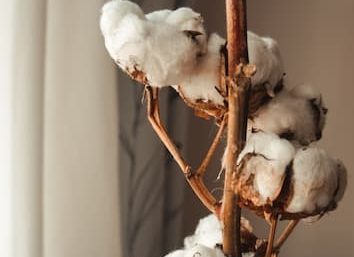
How is Organic Cotton Different from Conventional Cotton?
Share
Organic cotton and conventional cotton are two very different things grown from the same ancient subtropical shrub. Cotton in its raw form is the delicate, downy cellulose layer encasing the tiny seeds of a cotton plant. These same white fibres are harvested, washed and dyed before being spun into bed sheets, towels, bedding, clothing and fabrics. It's one of the oldest crops we know and a raw material that, depending on its treatment from origin to destination, can be loaded with personal, environmental and global implications.
The organic cotton crop vs the conventional cotton crop
The seed stock is where the difference between organic and conventional cotton first appears. Organic cotton crops are grown with a natural seed, that is a seed that comes from a lineage of plants, a blood line if you like, bringing with it the evolution inherent in its history. The conventional cotton crop is grown with GM (Genetically Modified) seed variants that are produced in a laboratory and do not have the capacity to reproduce themselves.
The natural seed stock is quite capable of growing with existing rainfall or within the boundaries of drip irrigation - a process that enables a large area of cotton to be grown with a small amount of water. In fact 70% of organic cotton crops are fed by natural rainfall alone when grown in suitable regions. Due to natural cotton's inherent strength and resilience pests, including weeds and bugs, can be controlled with hand weeding and naturally occuring pest predators.
The conventional cotton crop on the other hand must rely on enormous amounts of external irrigation. These are mostly drawn from ground and surface water sources, in fact 73% of all conventional cotton is grown using this method using a staggering 10 000 litres of water to produce just one kilogram of cotton. To make up for the shortfall in seed quality and the speed at which the crop needs to grow this water is then heavily supplemented with chemical fertilizers, herbicides, and pesticides. This practice depletes and contaminates water supplies and contributes to erosion, salination and pollution of the farmland and its surrounding ecosystem.
Overall conventional industrial cropping methods produce an enormous amount of cotton in a short span but leave a long term ecological footprint. Naturally grown organic cotton, on the other hand, is a slightly slower crop that comes to yield without any negative impact on the farmlands, surrounding environments or on the farmhands that tend it as it matures.
Hand harvesting vs machine harvesting
The purity of a cotton fibre is in its length. The style of harvest employed is what will inform the finished quality of each cotton fibre, and so the softness, durability and breathability of your sheets, towels and pillow cases.
Conventional cotton crops cannot be tended to by hand due to the levels of toxic chemicals needed for their production. Farm workers on conventional farms cannot enter the crops without protective clothing and respirators. This changes the way a crop must be harvested and is the next consideration when comparing conventional and organic cotton. Intensive chemical agriculture means harvesting of a conventional crop must be done by machine. Machine harvesters can pick large areas of cotton quickly and efficiently, think 1200 plants in 60 seconds. Unfortunately the machine lacks the fineness of the human hand and instead of picking, the cotton is torn from the seed casings resulting in a significant shortening of the fibre.
An organic cotton crop can be easily harvested by hand. A good picker can harvest about 20 plants in 10 minutes, a process that is certainly less time efficient but results in a quality long fibre product that can be spun into truly luxurious bedding and fabrics.
Organic cotton production vs conventional cotton production
Production refers to the dyeing and finishing of cotton products that can be achieved using a staggering amount of chemicals or none at all. These heavy metals remain in your sheets and towels for some time, even with repeated washing they will continue to impact the skin and respiratory system as we sleep.
When cotton is being produced using the conventional methods it is treated with chlorines, flame retardants, ammonia and formaldehyde among other known toxins. These dyes and chemical bleachers make pure white cotton a very dirty business.
An organic cotton processor must ensure that standards are met and maintained throughout. This means water based dyes only and no heavy metals or GM products can be used as cotton is spun and crafted for the market. As a result your organic cotton bed sheets feel softer, have no odour of dye or bleach and are 100% hypoallergenic.
In conclusion
To the consumer, the difference between organic and conventional cotton sheets, towels and bedding is in the feel, texture and breathability. However, the contrast between the two could not be more staggering, and is the reason ecoLinen is committed to bringing you an organic bedding product from the crop to a good night's sleep.
Conventional cotton production yields an inferior, short lived fibre whose growth, harvest and production is of increasing global concern. In contrast, organic cotton is a slow crop grown with few external resources. Pure, sustainable and high quality, durable, hypoallergenic and the only real choice for the wellbeing of those we love and the planet we all share.

